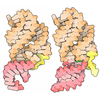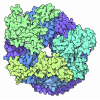+ Open data
Open data
- Basic information
Basic information
| Entry | Database: PDB / ID: 8qyx | ||||||
|---|---|---|---|---|---|---|---|
| Title | Human 60S ribosomal subunit | ||||||
 Components Components |
| ||||||
 Keywords Keywords | RIBOSOME / Large ribosomal subunit / HeLa / modifications / polyamines | ||||||
| Function / homology |  Function and homology information Function and homology informationtranslation at presynapse / exit from mitosis / eukaryotic 80S initiation complex / negative regulation of protein neddylation / response to insecticide / optic nerve development / regulation of translation involved in cellular response to UV / axial mesoderm development / negative regulation of formation of translation preinitiation complex / regulation of G1 to G0 transition ...translation at presynapse / exit from mitosis / eukaryotic 80S initiation complex / negative regulation of protein neddylation / response to insecticide / optic nerve development / regulation of translation involved in cellular response to UV / axial mesoderm development / negative regulation of formation of translation preinitiation complex / regulation of G1 to G0 transition / ribosomal protein import into nucleus / protein-DNA complex disassembly / positive regulation of intrinsic apoptotic signaling pathway in response to DNA damage by p53 class mediator / 90S preribosome assembly / retinal ganglion cell axon guidance / GAIT complex / positive regulation of DNA damage response, signal transduction by p53 class mediator / TORC2 complex binding / alpha-beta T cell differentiation / G1 to G0 transition / middle ear morphogenesis / cytoplasmic side of rough endoplasmic reticulum membrane / negative regulation of ubiquitin protein ligase activity / homeostatic process / macrophage chemotaxis / lung morphogenesis / male meiosis I / positive regulation of natural killer cell proliferation / Protein hydroxylation / Peptide chain elongation / Selenocysteine synthesis / Formation of a pool of free 40S subunits / cellular response to actinomycin D / Eukaryotic Translation Termination / blastocyst development / ubiquitin ligase inhibitor activity / SRP-dependent cotranslational protein targeting to membrane / Response of EIF2AK4 (GCN2) to amino acid deficiency / negative regulation of ubiquitin-dependent protein catabolic process / positive regulation of signal transduction by p53 class mediator / Viral mRNA Translation / Nonsense Mediated Decay (NMD) independent of the Exon Junction Complex (EJC) / protein localization to nucleus / GTP hydrolysis and joining of the 60S ribosomal subunit / positive regulation of protein binding / L13a-mediated translational silencing of Ceruloplasmin expression / Major pathway of rRNA processing in the nucleolus and cytosol / protein targeting / protein-RNA complex assembly / Nonsense Mediated Decay (NMD) enhanced by the Exon Junction Complex (EJC) / maturation of LSU-rRNA / rough endoplasmic reticulum / Maturation of protein E / Maturation of protein E / MDM2/MDM4 family protein binding / negative regulation of proteasomal ubiquitin-dependent protein catabolic process / ER Quality Control Compartment (ERQC) / Myoclonic epilepsy of Lafora / FLT3 signaling by CBL mutants / IRAK2 mediated activation of TAK1 complex / Prevention of phagosomal-lysosomal fusion / embryo implantation / Alpha-protein kinase 1 signaling pathway / Glycogen synthesis / IRAK1 recruits IKK complex / IRAK1 recruits IKK complex upon TLR7/8 or 9 stimulation / Endosomal Sorting Complex Required For Transport (ESCRT) / Membrane binding and targetting of GAG proteins / Negative regulation of FLT3 / Regulation of TBK1, IKKε (IKBKE)-mediated activation of IRF3, IRF7 / PTK6 Regulates RTKs and Their Effectors AKT1 and DOK1 / Regulation of TBK1, IKKε-mediated activation of IRF3, IRF7 upon TLR3 ligation / Constitutive Signaling by NOTCH1 HD Domain Mutants / IRAK2 mediated activation of TAK1 complex upon TLR7/8 or 9 stimulation / cytosolic ribosome / NOTCH2 Activation and Transmission of Signal to the Nucleus / TICAM1,TRAF6-dependent induction of TAK1 complex / TICAM1-dependent activation of IRF3/IRF7 / APC/C:Cdc20 mediated degradation of Cyclin B / cellular response to interleukin-4 / Downregulation of ERBB4 signaling / Regulation of FZD by ubiquitination / APC-Cdc20 mediated degradation of Nek2A / p75NTR recruits signalling complexes / ossification / InlA-mediated entry of Listeria monocytogenes into host cells / TRAF6 mediated IRF7 activation in TLR7/8 or 9 signaling / TRAF6-mediated induction of TAK1 complex within TLR4 complex / Regulation of pyruvate metabolism / NF-kB is activated and signals survival / Regulation of innate immune responses to cytosolic DNA / Pexophagy / Downregulation of ERBB2:ERBB3 signaling / NRIF signals cell death from the nucleus / VLDLR internalisation and degradation / Regulation of PTEN localization / Activated NOTCH1 Transmits Signal to the Nucleus / Regulation of BACH1 activity / Synthesis of active ubiquitin: roles of E1 and E2 enzymes / MAP3K8 (TPL2)-dependent MAPK1/3 activation Similarity search - Function | ||||||
| Biological species |  Homo sapiens (human) Homo sapiens (human) | ||||||
| Method | ELECTRON MICROSCOPY / single particle reconstruction / cryo EM / Resolution: 1.78 Å | ||||||
 Authors Authors | Wiechert, F. / Schacherl, M. / Sprink, T. | ||||||
| Funding support |  Germany, 1items Germany, 1items
| ||||||
 Citation Citation |  Journal: Nucleic Acids Res / Year: 2025 Journal: Nucleic Acids Res / Year: 2025Title: Visualizing the modification landscape of the human 60S ribosomal subunit at close to atomic resolution. Authors: Franziska Wiechert / Anett Unbehaun / Thiemo Sprink / Helena Seibel / Jörg Bürger / Justus Loerke / Thorsten Mielke / Christoph A Diebolder / Magdalena Schacherl / Christian M T Spahn /  Abstract: Chemical modifications of ribosomal RNAs (rRNAs) and proteins expand their topological repertoire, and together with the plethora of bound ligands, fine-tune ribosomal function. Detailed knowledge of ...Chemical modifications of ribosomal RNAs (rRNAs) and proteins expand their topological repertoire, and together with the plethora of bound ligands, fine-tune ribosomal function. Detailed knowledge of this natural composition provides important insights into ribosome genesis and function and clarifies some aspects of ribosomopathies. The discovery of new structural properties and functional aspects of ribosomes has gone hand in hand with cryo-electron microscopy (cryo-EM) and its technological development. In line with the ability to visualize atomic details - a prerequisite for identifying chemical modifications and ligands in cryo-EM maps - in this work we present the structure of the 60S ribosomal subunit from HeLa cells at the very high global resolution of 1.78 Å. We identified 113 rRNA modifications and four protein modifications including uL2-Hisβ-ox216, which stabilizes the local structure near the peptidyl transferase centre via an extended hydrogen-bonding network. We can differentiate metal ions Mg2+ and K+, polyamines spermine, spermidine and putrescine and identify thousands of water molecules binding to the 60S subunit. Approaching atomic resolution cryo-EM has become a powerful tool to examine fine details of macromolecular structures that will expand our knowledge about translation and other biological processes in the future and assess the variability of the chemical space due to differences between species/tissues or varying physicochemical environment. | ||||||
| History |
|
- Structure visualization
Structure visualization
| Structure viewer | Molecule:  Molmil Molmil Jmol/JSmol Jmol/JSmol |
|---|
- Downloads & links
Downloads & links
- Download
Download
| PDBx/mmCIF format |  8qyx.cif.gz 8qyx.cif.gz | 3.4 MB | Display |  PDBx/mmCIF format PDBx/mmCIF format |
|---|---|---|---|---|
| PDB format |  pdb8qyx.ent.gz pdb8qyx.ent.gz | Display |  PDB format PDB format | |
| PDBx/mmJSON format |  8qyx.json.gz 8qyx.json.gz | Tree view |  PDBx/mmJSON format PDBx/mmJSON format | |
| Others |  Other downloads Other downloads |
-Validation report
| Summary document |  8qyx_validation.pdf.gz 8qyx_validation.pdf.gz | 1.8 MB | Display |  wwPDB validaton report wwPDB validaton report |
|---|---|---|---|---|
| Full document |  8qyx_full_validation.pdf.gz 8qyx_full_validation.pdf.gz | 2 MB | Display | |
| Data in XML |  8qyx_validation.xml.gz 8qyx_validation.xml.gz | 238.6 KB | Display | |
| Data in CIF |  8qyx_validation.cif.gz 8qyx_validation.cif.gz | 459.3 KB | Display | |
| Arichive directory |  https://data.pdbj.org/pub/pdb/validation_reports/qy/8qyx https://data.pdbj.org/pub/pdb/validation_reports/qy/8qyx ftp://data.pdbj.org/pub/pdb/validation_reports/qy/8qyx ftp://data.pdbj.org/pub/pdb/validation_reports/qy/8qyx | HTTPS FTP |
-Related structure data
| Related structure data |  18765MC M: map data used to model this data C: citing same article ( |
|---|---|
| Similar structure data | Similarity search - Function & homology  F&H Search F&H Search |
- Links
Links
- Assembly
Assembly
| Deposited unit | 
|
|---|---|
| 1 |
|
- Components
Components
-Large ribosomal subunit protein ... , 5 types, 5 molecules A1U1g1D2E2
| #1: Protein | Mass: 29290.973 Da / Num. of mol.: 1 / Source method: isolated from a natural source / Source: (natural)  Homo sapiens (human) / Cell line: HELA / References: UniProt: P18124 Homo sapiens (human) / Cell line: HELA / References: UniProt: P18124 |
|---|---|
| #21: Protein | Mass: 16619.527 Da / Num. of mol.: 1 / Source method: isolated from a natural source / Source: (natural)  Homo sapiens (human) / Cell line: HELA / References: UniProt: P46776 Homo sapiens (human) / Cell line: HELA / References: UniProt: P46776 |
| #33: Protein | Mass: 14771.411 Da / Num. of mol.: 1 / Source method: isolated from a natural source / Source: (natural)  Homo sapiens (human) / Cell line: HELA / References: UniProt: P62987 Homo sapiens (human) / Cell line: HELA / References: UniProt: P62987 |
| #40: Protein | Mass: 28103.855 Da / Num. of mol.: 1 / Source method: isolated from a natural source / Source: (natural)  Homo sapiens (human) / Cell line: HELA / References: UniProt: P62917 Homo sapiens (human) / Cell line: HELA / References: UniProt: P62917 |
| #41: Protein | Mass: 46224.133 Da / Num. of mol.: 1 / Source method: isolated from a natural source / Source: (natural)  Homo sapiens (human) / Cell line: HELA / References: UniProt: P39023 Homo sapiens (human) / Cell line: HELA / References: UniProt: P39023 |
+60S ribosomal protein ... , 35 types, 35 molecules B1C1E1F1G1H1I1J1K1L1M1N1O1P1Q1R1S1T1V1W1X1Y1Z1a1b1c1d1e1f1i1...
-Protein , 1 types, 1 molecules D1
| #4: Protein | Mass: 24570.949 Da / Num. of mol.: 1 / Source method: isolated from a natural source / Source: (natural)  Homo sapiens (human) / Cell line: HELA / References: UniProt: Q96L21 Homo sapiens (human) / Cell line: HELA / References: UniProt: Q96L21 |
|---|
-RNA chain , 3 types, 3 molecules A2B2C2
| #37: RNA chain | Mass: 1640816.625 Da / Num. of mol.: 1 / Source method: isolated from a natural source / Source: (natural)  Homo sapiens (human) / Cell line: HELA Homo sapiens (human) / Cell line: HELA |
|---|---|
| #38: RNA chain | Mass: 38691.914 Da / Num. of mol.: 1 / Source method: isolated from a natural source / Source: (natural)  Homo sapiens (human) / Cell line: HELA / References: GenBank: 23898 Homo sapiens (human) / Cell line: HELA / References: GenBank: 23898 |
| #39: RNA chain | Mass: 50463.840 Da / Num. of mol.: 1 / Source method: isolated from a natural source / Source: (natural)  Homo sapiens (human) / Cell line: HELA / References: GenBank: 555853 Homo sapiens (human) / Cell line: HELA / References: GenBank: 555853 |
-Non-polymers , 8 types, 12074 molecules 
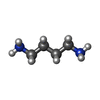


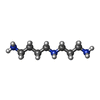
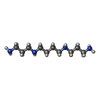









| #45: Chemical | ChemComp-MG / #46: Chemical | ChemComp-PUT / #47: Chemical | ChemComp-K / #48: Chemical | ChemComp-ZN / #49: Chemical | ChemComp-SPD / #50: Chemical | ChemComp-SPM / #51: Chemical | ChemComp-ATP / | #52: Water | ChemComp-HOH / | |
|---|
-Details
| Has ligand of interest | N |
|---|---|
| Has protein modification | Y |
-Experimental details
-Experiment
| Experiment | Method: ELECTRON MICROSCOPY |
|---|---|
| EM experiment | Aggregation state: PARTICLE / 3D reconstruction method: single particle reconstruction |
- Sample preparation
Sample preparation
| Component | Name: Human mature large ribosomal subunit / Type: RIBOSOME / Entity ID: #1-#44 / Source: NATURAL |
|---|---|
| Source (natural) | Organism:  Homo sapiens (human) Homo sapiens (human) |
| Buffer solution | pH: 7.5 |
| Specimen | Conc.: 0.4583 mg/ml / Embedding applied: NO / Shadowing applied: NO / Staining applied: NO / Vitrification applied: YES Details: Hela 60S ribosomal subunits were isolated from cytoplasmic extracts of Hela cells, involving puromycin treatment and sucrose gradient centrifugation in high salt. The gradients were manually ...Details: Hela 60S ribosomal subunits were isolated from cytoplasmic extracts of Hela cells, involving puromycin treatment and sucrose gradient centrifugation in high salt. The gradients were manually fractionated, and separated peak fractions of 60S subunits were collected. For buffer exchange, the sample was diluted 6 x in buffer F (20 mM HEPES pH7.5, 10 mM KCl, 2 mM MgCl2, 2 mM DTT) supplemented with 8.56 % sucrose to adjust the sucrose in the storage buffer to 12%, respectively. Finally, the 60S subunit suspension was concentrated on Amicon Ultracel filter units with a 10 kDa cutoff (Merck Millipore) was snap frozen in 10 ul aliquots and stored at -80 degrees Celsius. Concentrated Hela 60S ribosomal subunits were diluted to 200 nM in buffer E (20 mM HEPES pH7.5, 2 mM MgCl2, 90 mM KCl, 0.5 mM Spermidine, 0.04 mM Spermine, 2 mM DTT) and 4 ul were spotted onto glow-discharged holey carbon grids coated with a continuous thin carbon film (Quantifoil Cu200 R2/2+) and incubated for 40 sec at 4 degrees CelsiusC, 85% RH. The excess of liquid was blotted away for 2 sec and the grids were plunge frozen using the Vitrobot Mark IV (Thermo Fischer Scientific). |
| Specimen support | Details: Operated at 15 mA, easiGlow Discharge Cleaning system (PELCO) Grid material: COPPER / Grid mesh size: 200 divisions/in. / Grid type: Quantifoil R2/2 |
| Vitrification | Instrument: FEI VITROBOT MARK IV / Cryogen name: ETHANE / Humidity: 85 % / Chamber temperature: 277 K |
- Electron microscopy imaging
Electron microscopy imaging
| Experimental equipment |  Model: Titan Krios / Image courtesy: FEI Company |
|---|---|
| Microscopy | Model: FEI TITAN KRIOS |
| Electron gun | Electron source:  FIELD EMISSION GUN / Accelerating voltage: 300 kV / Illumination mode: FLOOD BEAM FIELD EMISSION GUN / Accelerating voltage: 300 kV / Illumination mode: FLOOD BEAM |
| Electron lens | Mode: BRIGHT FIELD / Nominal magnification: 105000 X / Nominal defocus max: 2500 nm / Nominal defocus min: 500 nm / Cs: 2.7 mm / C2 aperture diameter: 50 µm / Alignment procedure: COMA FREE |
| Specimen holder | Cryogen: NITROGEN / Specimen holder model: FEI TITAN KRIOS AUTOGRID HOLDER / Temperature (max): 82 K / Temperature (min): 80 K |
| Image recording | Electron dose: 49 e/Å2 / Film or detector model: GATAN K3 BIOQUANTUM (6k x 4k) / Num. of grids imaged: 1 / Num. of real images: 16983 |
| Image scans | Width: 11520 / Height: 8184 |
- Processing
Processing
| EM software |
| ||||||||||||||||||||||||||||||||||||||||||||||||||||||||||||
|---|---|---|---|---|---|---|---|---|---|---|---|---|---|---|---|---|---|---|---|---|---|---|---|---|---|---|---|---|---|---|---|---|---|---|---|---|---|---|---|---|---|---|---|---|---|---|---|---|---|---|---|---|---|---|---|---|---|---|---|---|---|
| CTF correction | Type: PHASE FLIPPING AND AMPLITUDE CORRECTION | ||||||||||||||||||||||||||||||||||||||||||||||||||||||||||||
| Particle selection | Num. of particles selected: 1372803 | ||||||||||||||||||||||||||||||||||||||||||||||||||||||||||||
| Symmetry | Point symmetry: C1 (asymmetric) | ||||||||||||||||||||||||||||||||||||||||||||||||||||||||||||
| 3D reconstruction | Resolution: 1.78 Å / Resolution method: FSC 0.143 CUT-OFF / Num. of particles: 880876 / Algorithm: BACK PROJECTION / Symmetry type: POINT | ||||||||||||||||||||||||||||||||||||||||||||||||||||||||||||
| Atomic model building | Protocol: OTHER / Space: REAL / Target criteria: Cross-correlation coefficient Details: Interactive model building was performed in Coot using an auto sharpened map in cryoSPARC and additionally a low-pass-filtered map to 4 Angstrom for the more mobile regions of the 60S ...Details: Interactive model building was performed in Coot using an auto sharpened map in cryoSPARC and additionally a low-pass-filtered map to 4 Angstrom for the more mobile regions of the 60S structure. Each residue of the model was checked individually for modifications and adjusted manually with a subsequent refinement in phenix.refine. Polyamines and metals were added while searching for unmodelled blobs in Coot. Water molecules were added using phenix.douse and visually validated in Coot. The model was validated using Molprobity. | ||||||||||||||||||||||||||||||||||||||||||||||||||||||||||||
| Atomic model building | PDB-ID: 6EKO Accession code: 6EKO / Source name: PDB / Type: experimental model | ||||||||||||||||||||||||||||||||||||||||||||||||||||||||||||
| Refine LS restraints |
|
 Movie
Movie Controller
Controller



 PDBj
PDBj













